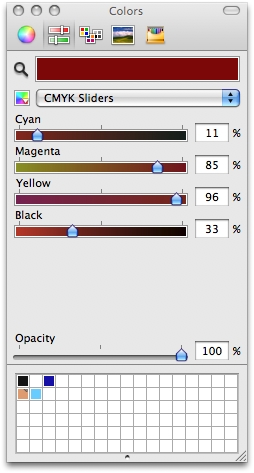iWork documents look elegant and professional on screen. To make them look equally impressive in a professional or commercial printed version, we need to convert them to a press-quality PDF format. Dealing with PDF production is one obstacle that many iWork users find difficult to overcome once they move beyond home or office printing.
Apple Macs have their own PDF-making application—Preview. You can also navigate to File | Export... | PDF to produce PDFs. These are sufficient for on-screen use or for printing out on desktop printers.
However, most professional printers or print-to-order websites can't—or won't—convert them from the computer screen, three-color mode (RGB) to the four-color print mode (CMYK). To produce commercially printable PDFs in CMYK mode, we need to add a PostScript (PS) stage and use Adobe Acrobat Distiller. Using the PostScript stage appears to be the only path by which CMYK color separation is possible for PDFs produced in iWork.
In current versions of Mac OS, you don't always have to export a file as PostScript and then open Acrobat to create your press-ready PDF. If you have Acrobat Professional, you can also set it up so that you can export the appropriate PDF from within iWork without going through the PS stage.
This recipe describes the process with the PS stage.
Follow these steps to create a press-ready PDF:
- Print a file to PS.
Under the File menu, click on Print, or type Command + P. When the Print dialog window opens, click on the PDF drop-down menu and choose Save as PostScript. As this will be your temporary work file, save it to the desktop. These files will have a
.psextension. - Launch Acrobat and open the PS file.
Adobe Acrobat has several options to create PDFs, including using the Create PDF option from the File menu. But rather than looking for PDF options under the Acrobat menus, drag the application icon to the Dock and then drag the PostScript (PS) file onto the Acrobat icon. Acrobat Distiller launches automatically, and after a few seconds produces an Adobe Acrobat PDF file. Distiller, which comes as part of the full professional Adobe Acrobat suite, can also be put in the Dock. You can drop PostScript files onto either Acrobat or Distiller icons.
- Save your new PDF document.
Now you have a CMYK press-ready PDF file.
Distiller has several preset settings depending on your required quality. These settings can be changed. Most printers will be happy to go through their requirements so that there are no hiccups during the printing process.
CMYK stands for Cyan (blue), Magenta (pink), Yellow, and Key (black). In printing presses, text and color images are created by mixing these four colors. Each color is spread in tiny dots on four separate plates—first cyan, then magenta, next yellow, and finally black. The black plate is the key plate—all the others are aligned with it. That's why black is called key in the CMYK acronym.
On our computer screens, colors are mixed automatically. The on-screen color mode is called RGB—red, green, and blue.
When professional printers prepare your work for printing, they use the CMYK color separation process. This is a highly specialized area where you don't need to venture.
However, understanding the basic principles of CMYK can be useful at the design stage. For example, when you are looking for a particular color, you can look up its CMYK reading in an existing iWork document. Click on the colored object, open Graphic Inspector and click on the color well. When the Colors viewer opens, click on the sliders and choose CMYK Sliders in the drop-down menu. It will show the CMYK reading. The following screenshot gives the CMYK description of the color called Cayenne in the crayons box.

You can give a co-worker the CMYK reading of a color that you mixed yourself, or if several people are working on a joint project where the colors have to be uniform, ask for the reading of a given color.
Some colors, for example, gold, have CMYK descriptions on Wikipedia. PostScript is a computer language that defines text and images, their characteristics, and the layout of the document. Its concept and development go back to the early days of computer design. In fact, it was Steve Jobs who urged Adobe engineers to adapt PostScript to be used as the language for laser printers. And when, in 1985, Apple introduced the LaserWriter, the first printer with PostScript, it sparked the desktop publishing revolution, which today allows us to produce high-quality projects on our home computers. PostScript is also the bridge between computers and large-scale commercial presses where CMYK color separation is needed.
This simple and efficient method works not only with iWork, but also with most other applications, including MS Word.
What if you don't have Acrobat Distiller?
If you need CMYK PDFs for a one-off project, save your iWork document to PostScript, put it on a USB stick, CD, or similar, and take the PS files to a friend with the full Acrobat Pro suite, which includes Distiller. Or, a computer service shop or a small professional printer may do the distilling and color separation from PS files for a reasonable fee.
However, if your project is of a continuous, long-term nature—periodical print publication, posters, cards, and so on—my advice would be to acquire the full professional Adobe Acrobat suite. Do a careful calculation, and you should find that even after buying/acquiring Acrobat you are still able to produce print-ready CMYK PDFs cost-efficiently.
- The MakingagoodPDFfromaniWorkdocument,andCMYKPDFsforprofessionalprinting recipe in Chapter 3, WorkingAcrossPlatformsandApplications
